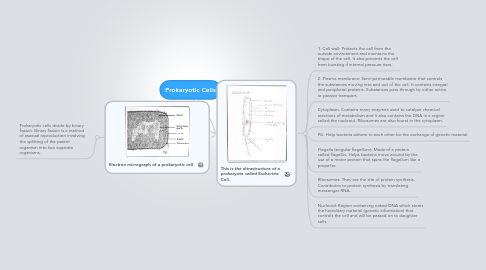Prokaryotic Cells
von Ludovica D'Angiò

1. Electron micrograph of a prokaryotic cell
1.1. Prokaryotic cells divide by binary fission. Binary fission is a method of asexual reproduction involving the splitting of the parent organism into two separate organisms.
2. This is the ultrastructure of a prokaryote called Eschericia Coli.
2.1. 1. Cell wall: Protects the cell from the outside environment and maintains the shape of the cell. It also prevents the cell from bursting if internal pressure rises.
2.2. 2. Plasma membrane: Semi-permeable membrane that controls the substances moving into and out of the cell. It contains integral and peripheral proteins. Substances pass through by either active or passive transport.
2.3. Cytoplasm: Contains many enzymes used to catalyze chemical reactions of metabolism and it also contains the DNA in a region called the nucleoid. Ribosomes are also found in the cytoplasm.
2.4. Pili: Help bacteria adhere to each other for the exchange of genetic material.
2.5. Flagella (singular flagellum): Made of a protein called flagellin. Helps bacteria move around by the use of a motor protein that spins the flagellum like a propeller.
2.6. Ribosomes: They are the site of protein synthesis. Contributes to protein synthesis by translating messenger RNA.
2.7. Nucleoid: Region containing naked DNA which stores the hereditary material (genetic information) that controls the cell and will be passed on to daughter cells.


